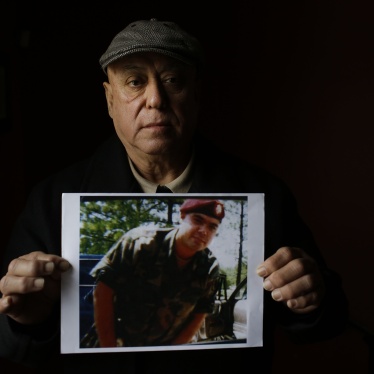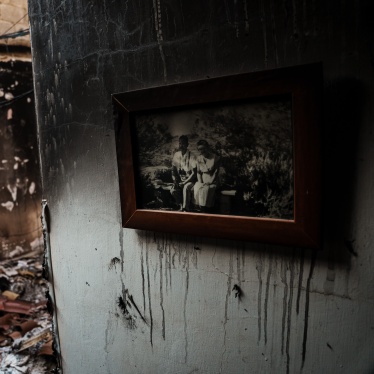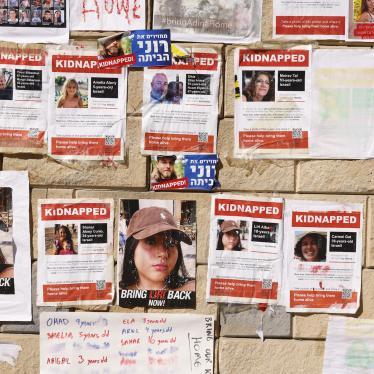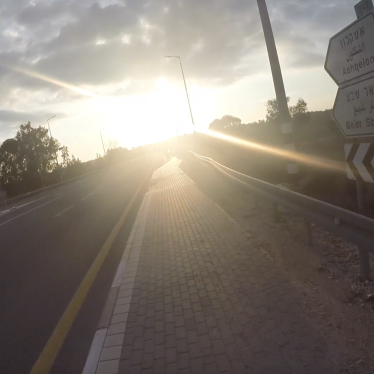June 13, 2024
Assistant Attorney General Kristen Clarke
US Department of Justice
Civil Rights Division
Robert F. Kennedy Department of Justice Building
950 Pennsylvania Avenue NW
Washington, DC, 20530 United States
Re: The US Should Swiftly Investigate and Report on Allegations of Abuse, Including the Beating of a Migrant Man to Death by US Law Enforcement Officers
Dear Assistant Attorney General Clarke:
Human Rights Watch is an international, nonprofit, non-governmental organization that investigates and reports on abuses around the world, based on accurate factfinding and impartial reporting.
Human Rights Watch submits this complaint detailing two categories of alleged mistreatment of migrants in the El Paso, Texas region. We urge the Civil Rights Division of the US Department of Justice to immediately investigate and publicly report on 1) allegations that Texas National Guard soldiers, Texas Department of Public Safety (DPS) officers, other state National Guard or police, and/or Border Patrol agents took part in pushbacks of asylum seekers, shooting migrants and journalists with pepper-spray projectiles,[1] and verbally and psychologically abusing migrants, from at least May 1 through May 30, 2024; as well as 2) allegations that one or more officers from one or more of the before-named agencies physically assaulted several migrants and beat to death one migrant man in El Paso, Texas, on May 17, 2024. If true, some, or all of, these abuses may constitute incidents of excessive use of force, and/or violations of fundamental rights under United States, Texas, and international human rights law.[2]
1. Allegations that Law Enforcement Officials Engaged in a Range of Abuses, Including Excessive Use of Force, Verbal and Psychological Abuse, and Pushbacks of Asylum-Seekers Near El Paso Texas, from at least May 1 through May 30, 2024.
According to news media, Texas National Guard soldiers, Texas Department of Public Safety officers, and potentially other state law enforcement or National Guard soldiers, including from Iowa, Indiana, and Florida,[3] have engaged in a range of alleged abuses of migrants near El Paso, Texas, from at least May 1 through May 30, 2024.[4]
An unidentified Texas Military Department official told USA Today that Texas National Guard soldiers are now being trained to fire pepper-spray projectiles and said their objective is to saturate the ground, presumably on the Mexican side of the border, to deter migrants and asylum seekers from approaching the border.[5] The official reportedly said that walking over the pepper-spray projectiles is like “climbing through a jalapeño bush.”[6]
Multiple journalists witnessed or documented Texas National Guard soldiers located in El Paso firing less-lethal rounds, including pepper-spray projectiles, at migrants, including families with small children, located on the Mexican side of the border, including on the mornings of May 28 and May 30, 2024.[7] According to Border Report, two migrants told journalists they were in groups of people waiting on the Ciudad Juárez side of the Rio Grande, and not attempting to cross the river, when they were fired on, prompting them to try to use cardboard and blankets to shield themselves.[8] According to EFE, migrant families told reporters that Texas National Guard soldiers fired the less-lethal rounds upon them while they were sleeping at an encampment in Ciudad Juárez, Chihuahua. [9] Also according to EFE, a group of journalists from El Paso and Ciudad Juárez reportedly witnessed Texas soldiers firing pepper-spray projectiles at migrants on May 30.[10] According to Border Report, some migrants reported having been struck and bruised by the less-lethal projectiles, showing bruises and pepper-spray projectiles to reporters.[11] A photographer for El Heraldo de Juarez reported soldiers also fired less-lethal rounds at him on May 28, shooting twice, and Border Report said it recorded a Texas soldier standing in El Paso aiming a launcher at the Rio Grande and firing at least one less-lethal round.[12]
Prior to these events, in April 2024, a New York Post article reported that according to a “National Guard source,” unnamed in the article, Texas National Guard soldiers have been issued less-lethal “pepper ball ammo to deter would-be border crossers.”[13]
The accounts describing individuals being hit by the pepper-spray projectiles may conflict with the following description provided by Texas Military Major General Thomas Suelzer at a hearing of the Texas Senate Committee on Border Security on June 11, 2024:
The way it’s used in practice, those rounds are used for area saturation, so we train our solders to hit an inanimate object in the proximity of the person you are trying to turn around so that the pepperball ruptures and the pepper material sprays out. Oftentimes, if you see it on video, you’ll hear these multiple rounds like “boom, boom, boom, boom.” What they’re trying to do is to hit the fence near these folks so that the pepper disperses. We specifically train them do not shoot directly at an individual because if hit in the wrong place, it can cause serious bodily injury.[14]
Human Rights Watch is concerned that the alleged conduct may constitute incidents of excessive use of force under international human rights law. It is unclear, absent further investigation by your office or by other authorities, whether these uses of force were strictly necessary under the circumstances, and proportionate to a legitimate objective, as required under international standards. Moreover, we remind you that even less-lethal forms of force can be excessive and lead to injuries and death. Human Rights Watch has documented numerous cases where less-lethal projectiles lodged themselves in victims’ bodies, often in the head or chest, causing injury to or loss of eyes, perforated chests, brain damage, cardiogenic shock, and even death.[15]
There are also allegations that asylum seekers are being pushed back, or otherwise coerced, into returning to Mexico. According to a USA Today report, a man traveling with his 5-year-old daughter, who USA Today ascertained was seeking asylum, made it past a “patrol vehicle” and was clinging to the border wall because he thought one needed to touch the border wall to seek asylum. He clung to the wall in the hope Border Patrol would soon arrive when an official, identified in the article as a “guard” dressed in “camouflage,” taunted him and his daughter, saying they would give his dehydrated child water if he would agree to give up and return to Mexico while showing the child a bottle of water.[16] According to migrants interviewed by EFE for a May 30 article, when journalists are not present and migrants try to cross the river, Texas National Guard soldiers verbally abuse them, point weapons at them, and physically prevent them from crossing the border. Also, according to the article, some National Guard soldiers advance up to the midway point of the Rio Grande and fire less-lethal rounds at migrants, even after they have returned to the Mexican side of the Rio Grande.”.[17]
Human Rights Watch is concerned these reports indicate that Texas National Guard troops (or other law enforcement) may have attempted to, or successfully, push back asylum seekers, in violation of the principle of nonrefoulement in US and international refugee and human rights law.[18]
Because refugee status is declaratory,[19] the fundamental principles of refugee protection apply equally to asylum seekers who have not been formally recognized as refugees. In 1996, UNHCR's Executive Committee, of which the United States is a member, reiterated in Conclusion 79 that the principle of nonrefoulement prohibits the return of refugees "whether or not they have formally been granted refugee status.”[20]
The principle of nonrefoulement applies not only within the territory of a state, but also to rejection of asylum seekers at their borders. In its October 2004 meeting, UNHCR's Executive Committee issued Conclusion 99, which calls on States to ensure "full respect for the fundamental principle of nonrefoulement, including non-rejection at frontiers without access to fair and effective procedures for determining status and protection needs.”[21]
Finally, the accounts gathered by journalists and migrants include no reference to Border Patrol personnel being present or accessible. The absence of Border Patrol, the agency tasked by the US government with the apprehension of migrants and processing of asylum seekers, raises further questions, including whether and how asylum seekers are meant to access the credible fear process – especially in light of the announcement on June 5 of an executive proclamation and interim final rule to suspend the entry of noncitizens at the southwest border,[22] and the ongoing use of the government CBP One smartphone application to meter asylum seekers’ access to ports of entry, which has separately led to human rights abuses reported on by Human Rights Watch.[23] The Department of Justice should investigate and report publicly on the extent to which the Border Patrol, if at all, shares responsibility through actions or omissions for the events outlined in this complaint.
2. Allegations that Law Enforcement Officials Beat a Migrant Man to Death Near El Paso, Texas, on May 17, 2024
According to a statement to a reporter from a Venezuelan migrant who was in a group of migrants that sought to cross the US-Mexico border near El Paso, Texas,[24] in the early morning hours of May 17, 2024, the group was confronted by unknown US personnel, who allegedly physically beat the migrants in an effort to block them from entering the United States.[25] The Venezuelan migrant told a reporter that US officials beat one man, who was from Honduras, when he crossed with others at around 2 a.m., took him into custody, and subsequently expelled him hours later to Ciudad Juárez in critical condition, around 7 a.m.[26]
The man’s body was recovered by Ciudad Juárez police on the banks of the Rio Grande in Mexico, near multiple high-traffic ports of entry connecting Ciudad Juárez to El Paso – these include the Ysleta/Zaragoza Bridge, the Bridge of the Americas, the Stanton Bridge, and the Paso del Norte Bridge, which leads into downtown El Paso.[27] The Venezuelan migrant told a reporter that the man’s face had been beaten so badly his nasal septum was sunken and he had bruises all over his body.[28] The man, who has not yet been identified publicly but who bears a tattoo on his abdomen that reads “Vicky,” subsequently died of severe head trauma, according to forensic investigators with the Chihuahua state prosecutor’s office.[29] The Chihuahua state prosecutor’s office estimated the deceased man’s age was between 30 and 35-years-old.[30]
The press accounts of these incidents provide no details allowing for further identification of the people or person responsible for these abuses. Human Rights Watch’s own research and other sources make clear that there are many US law enforcement agencies working in that particular border region near El Paso, including Texas National Guard, Florida National Guard, Texas Department of Public Safety (DPS), US Border Patrol, and other US state officials.[31]
According to an El Diario article on the Honduran man’s death, there are multiple cameras in the area where witnesses reported the incident took place.[32] According to the article, some cameras are alleged to be operated by private security companies on the Mexican side of the border, and others are alleged to be operated by the US government. [33] That camera footage may be able to shed light on the events that transpired, and Human Rights Watch urges CBP and the Ciudad Juárez municipal and Chihuahua state governments to preserve and make public any video evidence.
The allegation that the man was held for hours in the United States raises serious concerns that US-based authorities may have been involved in the incident.[34] Human Rights Watch contacted the CBP Office of Professional Responsibility (OPR) about the incident on May 18 – the agency responded to Human Rights Watch on May 19 to say they would look into the matter. On June 11, an OPR official told Human Rights Watch that CBP had preserved video evidence of the incident.
Given these allegations, Human Rights Watch calls on the Department of Justice to investigate, including by interviewing non-US-citizen witnesses of any nationality, wherever they may be located:
- The incidents of use of force, including possibly excessive use of force, and mistreatment described in this letter to determine the facts;
- Provide a detailed accounting, with regard to each specific incident, of the use of force or other forms of mistreatment, and the specific law enforcement agency that engaged in that use of force or other forms of mistreatment;
- Determine whether the incidents of use of force and mistreatment violated federal, state or local laws;
- Determine, with regard to each specific incident of other forms of mistreatment, the specific law enforcement agency or agencies that engaged in those actions and whether these violated federal, state, or local laws;
- Make public a detailed description for each use of force incident, or other forms of mistreatment, of what measures of accountability are under consideration and/or will be taken by the law enforcement agencies involved, as well as by the Justice Department; and
- Determine what the chain of command and operational oversight and jurisdictional responsibilities are for each of the law enforcement agencies, including but not limited to those named in this letter, operating at the US-Mexico border.
With regard to the alleged beating to death of the migrant by US law enforcement, we further urge:
- That the US and Mexican governments immediately commit to preserving and reviewing any relevant digital evidence, including surveillance camera and body camera footage;
- That the US and Mexican governments make every effort to identify the man who was killed; and
- That the US government provide the man’s family with legal counsel and pay for the repatriation and dignified disposition of his remains.
Thank you for your consideration of this matter. We look forward to your response.
Sincerely yours,
Ari Sawyer
US Border Researcher
CC: Gilberto Loya Chávez, Secretary of Public Security for the State of Chihuahua
CC: César Omar Muñoz Morales, Secretary of Public Security for Ciudad Juárez
[1] In this letter, we use the term “pepper-spray projectile” for kinetic impact projectiles containing a chemical irritant commonly referred to as “pepperballs.”
[2] “Excessive force” is used in this complaint to refer to force that exceeds what is objectively reasonable and necessary in the circumstances confronting the officer, as in Article 3 of the U.N. Code of Conduct for Law Enforcement Officials, which provides that: “Law enforcement officials should use force only when strictly necessary and to the extent required for the performance of their duty” and in the U.N. Basic Principles on the Use of Force and Firearms by Law Enforcement Officials, which provides that: “Whenever the use of force and firearms is unavoidable, law enforcement officials shall exercise restraint in such use and act in proportion to the seriousness of the offence and the legitimate objective to be achieved.” U.N. Code of Conduct for Law Enforcement Officials, GA resolution 34/169, December 17, 1979; U.N. Basic Principles on the Use of Force and Firearms by Law Enforcement Officials, UN Doc. A/CONF.144/28/Rev.1 (1990); In Graham v. Connor 490 U.S. 386 (1989), the United States Supreme Court held that that the United States Constitution's Fourth Amendment requirement of “reasonableness” on the part of law enforcement applies to “all claims that law enforcement officials have used excessive force - deadly or not - in the course of an arrest, investigatory stop, or other seizure of a free person.”
[3] Lauren Villagran, “Wedged Between Politics and Texas Muscle, Migrants Thread Dangerous Path Across Border,” USA Today, June 8, 2024, https://www.usatoday.com/story/news/politics/elections/2024/06/08/migrants-face-tough-path-mexico-border/73818094007/ (accessed June 8, 2024).
[4] We have no basis upon which to conclude that these alleged abuses have ended, nor is it clear from public sources when these alleged abuses began.
[5] Villagran, “Wedged Between Politics and Texas Muscle, Migrants Thread Dangerous Path Across Border,” USA Today.
[6] Ibid.
[7] Julian Resendiz, “Asylum-Seeking Families Take Cover After Texas National Guard Fires Pepper Balls,” Border Report, May 28, 2024, https://www.borderreport.com/immigration/asylum-seeking-families-take-cover-after-texas-national-guard-fires-pepper-balls/ (accessed May 31, 2024); EFE Noticias, “Migrantes acusan a la Guardia de Texas de dispararles mientras duermen en México,” May 30, 2024, https://es-us.noticias.yahoo.com/migrantes-acusan-guardia-texas-dispararles-190752194.html?guccounter=1 (accessed June 7, 2024); Villagran, “Wedged Between Politics and Texas Muscle, Migrants Thread Dangerous Path Across Border,” USA Today.
[8] Resendiz, “Asylum-Seeking Families Take Cover After Texas National Guard Fires Pepper Balls,” Border Report.
[9] EFE Noticias, “Migrantes Acusan a la Guardia de Texas de Dispararles Mientras Duermen en México.”
[10] Ibid.
[11] Resendiz, “Asylum-Seeking Families Take Cover After Texas National Guard Fires Pepper Balls,” Border Report.
[12] Ibid.
[13] Jennie Taer, “Texas Authorities Armed with ‘Thousands’ of Pepperballs Instructed to go Full Force Against Migrants Arriving by ‘The Beast’ Train to El Paso Border,” New York Post, April 26, 2024, https://nypost.com/2024/04/26/us-news/texas-authorities-armed-with-thousands-of-pepperballs-instructed-to-go-full-force-against-migrants-arriving-at-el-paso-border (accessed June 7, 2024).
[14] The Texas Senate, Senate Committee on Border Security Hearing, “Testimony of Texas Military Major General Thomas Suelzer,” video, June 11, 2024, at 1:03:46, https://tlcsenate.granicus.com/MediaPlayer.php?view_id=54&clip_id=18517 (accessed June 12, 2024).
[15] Jonathan Pedneault (Human Rights Watch), “Police Targeting ‘Street Medics’ at US Protests,” commentary, Human Rights Watch, June 17, 2020, https://www.hrw.org/news/2020/06/17/police-targeting-street-medics-us-protests; Human Rights Watch, “Chile Police Reforms Needed in the Wake of Protests,” Human Rights Watch news release, November 26, 2019, https://www.hrw.org/news/2019/11/26/chile-police-reforms-needed-wake-protests.
[16] Villagran, “Wedged Between Politics and Texas Muscle, Migrants Thread Dangerous Path Across Border,” USA Today.
[17] EFE Noticias, “Migrantes acusan a la Guardia de Texas de dispararles mientras duermen en México.”
[18] 8 U.S.C. § 1158: Stating “Any alien who is physically present in the United States or who arrives in the United States (whether or not at a designated port of arrival and including an alien who is brought to the United States after having been interdicted in international or United States waters), irrespective of such alien's status, may apply for asylum in accordance with this section or, where applicable, section 1225(b) of this title”; Protocol Relating to the Status of Refugees, 606 U.N.T.S. 267, entered into force October 4, 1967, art. 1: Incorporating the substantive obligations of the UN Convention Relating to the Status of Refugees, including article 33 prohibiting refoulement; American Convention on Human Rights, (“Pact of San José, Costa Rica”), adopted November 22, 1969, O.A.S. Treaty Series No. 36, 1144 U.N.T.S. 123, entered into force July 18, 1978, art. 22(7).
[19] United Nations High Commissioner for Refugees (UNHCR), Handbook on Procedures and Criteria for Determining Refugee Status under the 1951 Convention and the 1967 Protocol relating to the Status of Refugees, reissued February 2019, Geneva, HCR/1P/4/ENG/REV. 4, para. 28, https://www.unhcr.org/us/media/handbook-procedures-and-criteria-determining-refugee-status-under-1951-convention-and-1967 (accessed June 12, 2024).
[20] UNHCR Conclusion 79 (XLVII), “General Conclusion on International Protection,” October 11, 1996, A/AC.96/878 and document No. 12A (A/51/12/Add.1), https://www.unhcr.org/us/publications/general-conclusion-international-protection-13 (accessed June 12, 2024), para. (j).
[21] UNHCR Conclusion 99 (LV), “General Conclusion on International Protection,” October 8, 2004, A/AC.96/1003, https://www.unhcr.org/us/publications/general-conclusion-international-protection-11 (accessed June 12, 2024), para. (l); Emphasis added.
[22] The White House, “A Proclamation on Securing the Border,” June 4, 2024, https://www.whitehouse.gov/briefing-room/presidential-actions/2024/06/04/a-proclamation-on-securing-the-border/ (accessed June 7, 2024).
[23] Human Rights Watch, “We Couldn’t Wait”: Digital Metering at the US-Mexico Border, (New York: Human Rights Watch, 2024), https://www.hrw.org/report/2024/05/01/we-couldnt-wait/digital-metering-us-mexico-border.
[24] Liliana Torreso, “Señalan migrantes que agentes de Estados Unidos mataron a compañero en la orilla del río,” Heraldo de Juárez, May 17, 2024, https://www.elheraldodejuarez.com.mx/policiaca/senalan-migrantes-que-agentes-de-estados-unidos-mataron-a-companero-en-la-orilla-del-rio-11934089.html/amp (accessed May 31, 2024).
[25] Ibid.
[26] Ibid.
[27] According to the prosecutor’s office in Ciudad Juárez, the man’s body was discovered near the end of Calle Paseo del Nogal where it meets Boulevard Juan Pablo II (31.716043, -106.374703). See: Fiscalía General del Estado de Chihuahua, “Investiga FGE muerte de un masculino en límites fronterizos,” news release, May 17, 2024, http://fiscalia.chihuahua.gob.mx/investiga-fge-muerte-de-un-masculino-en-limites-fronterizos/ (accessed May 31, 2024).
[28] Torreso, “Señalan migrantes que agentes de Estados Unidos mataron a compañero en la orilla del río,” Heraldo de Juárez.
[29] Javier Olmos, “En ceros, investigación por hondureño muerto en el bordo,” Diario, May 19, 2024, https://diario.mx/juarez/en-ceros-investigacion-por--hondureno-muerto-en-el-bordo-20240519-2177277.html (accessed May 31, 2024); Associated Press, “Migrante hallado sin vida en el río Bravo murió por golpe en la cabeza, informó fiscalía,” Telemundo 48 El Paso, May 21, 2024, https://www.telemundo48elpaso.com/noticias/local/migrante-hallado-ssin-vida-en-el-rio-bravo-murio-por-golpe-en-la-cabeza-informo-fiscalia/2357347/ (accessed May 31, 2024); Ricardo González, “Pedirán apoyo de embajadas para identificar a migrante que murió por golpes en el bordo,” Heraldo de Juárez, May 20, 2024, https://www.elheraldodejuarez.com.mx/local/juarez/pediran-apoyo-de-embajadas-para-identificar-a-migrante-que-murio-por-golpes-en-el-bordo-11946411.html (accessed May 31, 2024).
[30] Olmos, “En ceros, investigación por hondureño muerto en el bordo,” Diario.
[31] Rebecca Kheel, “More Republican Governors Deploy National Guard Troops to Texas Border,” Military.com, August 1, 2023, https://www.military.com/daily-news/2023/08/01/more-republican-governors-deploy-national-guard-troops-texas-border.html (accessed June 2, 2024); Villagran, “Wedged Between Politics and Texas Muscle, Migrants Thread Dangerous Path Across Border,” USA Today.
[32] Olmos, “En ceros, investigación por hondureño muerto en el bordo,” Diario.
[33] Ibid.
[34] Torreso, “Señalan migrantes que agentes de Estados Unidos mataron a compañero en la orilla del río,” Heraldo de Juárez.




